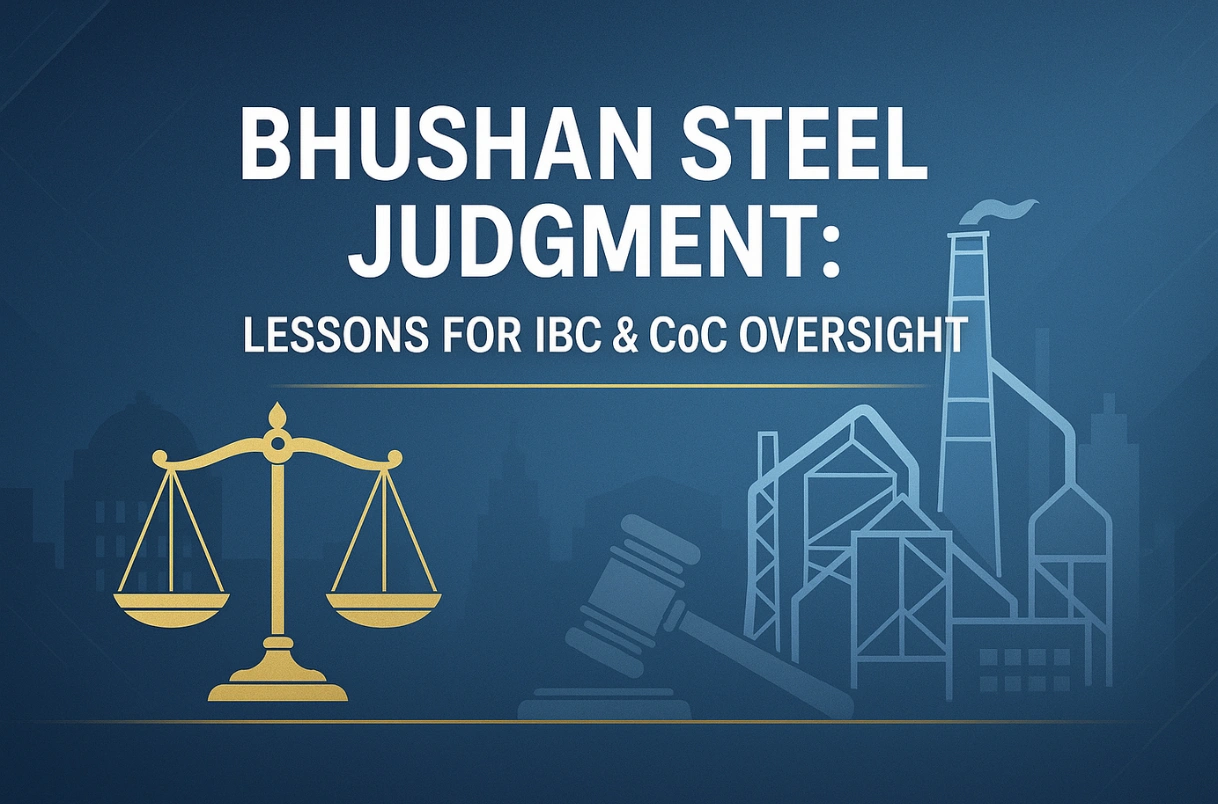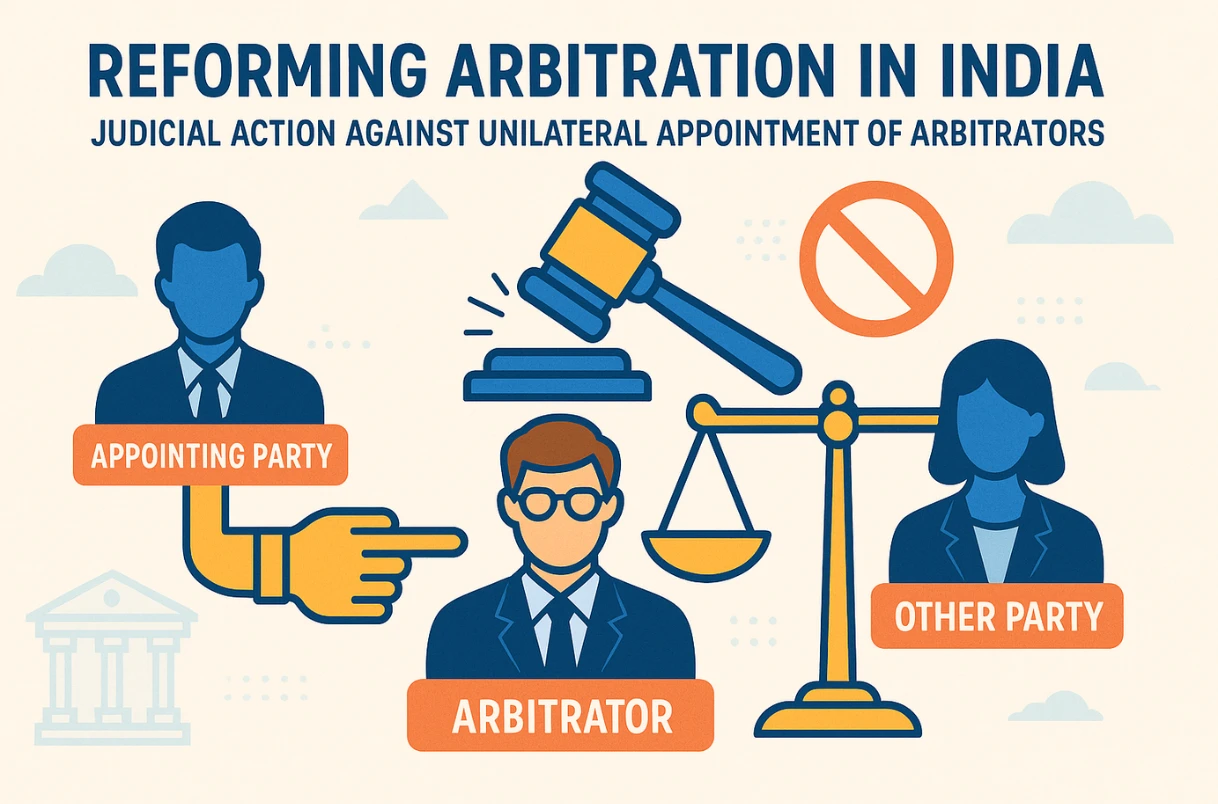Insolvency and Bankruptcy Code: Lessons from the Bhushan Steel Case and IBBI’s Role in Strengthening CIRP

By – Shreya Dubey and Nikhil Anand
Table of Contents
Introduction
The Insolvency and Bankruptcy Code, 2016 (“IBC”) is approaching its first decade, yet it remains a dynamic and evolving statute, having undergone many amendments till date.
As India’s inaugural mechanism intended to reinvigorate economic growth and release stressed assets, the IBC demands constant vigilance to identify procedural gaps and legal loopholes. That task falls squarely on the Insolvency and Bankruptcy Board of India (“IBBI”).
A particularly pressing challenge for the IBBI has now emerged in the wake of the Supreme Court’s decision in Kalyani Transco v. Bhushan Power & Steel1, which witnessed a heavy litigation history, followed by implementation of the Resolution Plan only to end up with directions for liquidation of Bhushan Power & Steel -Corporate Debtor. The manner in which insolvency proceedings have been conducted in this matter have received much flak from the Supreme Court, as while the IBC has stringent checks & balances in place including penalties on violation of the Code, yet all participants in this case have managed to dodge the streamlined procedure to conduct the entire Corporate Insolvency Resolution Process as per their collective discretion.
The Bhushan Steel judgment is now one of the most important insolvency case studies in India, highlighting why judicial intervention in CoC functioning has become crucial.
The CIRP Framework: Timelines and Objectives
The CIRP replaced certain provisions of the Companies Act, 1956 and the Sick Industrial Companies (Special Provisions) Act, 1985, amongst others to consolidate insolvency and liquidation framework, into one consolidated framework.
Under this two-stage framework, CoC and an RP get up to 180 + 90= 270 days (capped at 330 days) to rescue a distressed company as a going concern and unlock its true value. If no viable plan wins the approval of CoC, the IBC triggers liquidation, declaring “bankruptcy” of the Corporate Debtor, so that assets can be sold, and proceeds distributed. The idea behind this mandatory process is to secure the Code’s primary objective i.e., value maximization, because selling a company as a going concern saves employment and yields greater value than piecemeal asset sales, that too at depreciated value.
Therefore, even the timeline for conclusion of the CIRP requires strict compliance since delays erode potential recoveries and undermine value maximization, defeating the entire purpose of the insolvency process.
This responsibility entirely rests with the CoC and the Resolution Professional, who are vested with the responsibility of examining and certifying the “feasibility “and “fitness” of a Resolution Plan before submission of the same for approval of the National Company Law Tribunal (“Adjudicating Authority”).
The Role of CoC and Resolution Professionals Under IBC
The IBC regime, which has introduced the concept of CoC and Resolution Professional has placed significant reliance on creditors to steer the Corporate Debtor through CIRP, the compliance check is to be carried by the Resolution Professional. To facilitate autonomy in the decision making process, the decisions of the CoC are shielded by the “commercial wisdom” doctrine, upon which the judiciary has extended considerable deference.
The concept of commercial wisdom traces its roots to the principle of “non-justiciability” in terms whereof, certain issues or disputes are not deemed suitable for resolution by courts of law, signifying a limitation on the power of judicial review2.
The CoC’s autonomy in matters of approval or rejection of a resolution plan based on their commercial decision was elaborated in the case of K. Shashidhar v. Indian Overseas Bank3, wherein the Supreme Court observed that NCLT’s jurisdiction is limited to the NCLT being satisfied that the resolution plan meets the requirements specified in Section 30(2) of the IBC and contains provisions in relation to (i) the payment of insolvency resolution process costs in a specified manner in priority to the repayment of other debts of the corporate debtor, (ii) the repayment of the debts of operational creditors (iii) the management of the affairs of the corporate debtor, (iv) the implementation and supervision of the resolution plan, (v) does not contravene any of the provisions of the law (vi) conforms to such other requirements as may be specified by the Board and therefore the role of the NCLT while considering a Resolution Plan has been circumscribed.
In Committee of Creditors of Essar Steel India Limited vs. Versus Satish Kumar Gupta & Ors4, against NCLAT’s stark observation that CoC has not been empowered to decide the manner in which the distribution is to be made between one or other creditors, as there would be a conflict of interest between financial and operational creditors, the Supreme Court stepped in to uphold CoC’s commercial wisdom on taking business decisions based on ground realities by a majority, since a CoC does not act in a fiduciary capacity to any group of creditors, and a Tribunal’s judgment cannot substitute CoC’s wisdom.
Over the years, the commercial wisdom of the CoC has been protected by the Courts and judicial review of CoC’s decision have focussed on legality alone, not commercial merits.
In fact, it is a statutory obligation cast under Section 30(2) of the IBC upon the Resolution Professional to scrutinise the Resolution Plan submitted by the Resolution Applicant, in terms of eligibility of the Resolution Applicant, including but not limited to verifying whether the Plan so submitted is full proof. The collective participants in this exercise are the Resolution Applicant, Resolution Professional and the CoC, who are jointly required to ensure that the requirements of the IBC are met, before a Resolution Plan is submitted to the Adjudicating Authority for approval.
While it is not unheard of that Resolution Professionals have often engaged in misconduct and acts of dereliction of duties under the IBC, and consequently, the Tribunal has under many instances referred the conduct to be investigated by IBBI for appropriate action5. The IBBI now witnesses collective violation of the IBC framework by all stakeholders involved and has ceased various challenges that lie ahead. Judicial intervention in CoC decision-making remains limited, but cases like Bhushan Steel show the need for a tighter check on commercial wisdom under IBC.
The Bhushan Steel Case: Where the Process Went Wrong
The recent judgment in the matter Bhushan Steel6 is one such example which throws light on the glaring departures from the statutory framework collectively done by Resolution Professional, Resolution Applicant, the CoC and overlooked by the NCLT. It is not only the commercial wisdom of the CoC that was put to the test of judicial scrutiny but also the flagrant violations of the procedures done by the Resolution Professional, in discharge of its duties under the Code, and jurisdictional errors committed by the Adjudicating Authority while approving the Resolution Plan. Bhushan Steel judgment under the Supreme Court IBC ruling exposed severe IBC Code violations, including procedural lapses and Resolution Professional misconduct. A brief recap of the departures done by the stakeholders and as summarised by the Supreme Court are as under –
Deviation from Bidding Procedure
Resolution Applicant JSW had acquired the highest score amongst the three Prospective Resolution Applicants, the CoC however failed to declare the H1 and H2 bidders. Instead, the Core Committee, consisting of a Small Group of Lenders and the Resolution Applicant proceeded to negotiate further, following which the Consolidated Resolution Plan was submitted by JSW. Record of Meetings reflected the objections raised on the procedure being followed by the CoC, deviations from original Resolution Plan, priority being given to Financial Creditors over Operational Creditors, ironically NCLT also granted approval to the Resolution Plan, brushing aside these glaring violations under the carpet.
Breach of Timelines Under Section 12
The Code under Section 12 mandates the CIRP to be completed within a period of 180 days from the date of admission of the application to initiate such a process. Extensions are not automatic and require a formal application to the Adjudicating Authority after a resolution is passed by the CoC by a 66% voting. The CoC and the Resolution Professional, collectively failed to seek extension within the stipulated time frame of 180 days and the Resolution Plan came to be approved by NCLT after the expiry of maximum limitation under the IBC, thereby adding to the jurisdictional delay committed by NCLT to the list of defaults already committed by the CoC and the Resolution Professional.
Ineligibility of Resolution Applicant
The IBC under Section 29, Section 30(1) and Section 39(1) thereof mandate the Resolution Applicant to make proper disclosures with respect to association with the Corporate Debtor and an affidavit as to such eligibility is also to be submitted along with the Resolution Plan. Resolution Professional is also required to certify the eligibility and compliance by the Resolution Applicant.
Ironically, the Resolution Applicant in this case was a ‘related party’ to Corporate Debtor and not eligible to participate in the CIRP from its very onset. No Compliance Certificate was filed the Resolution Professional certifying the eligibility and the Resolution Plan was filed before NCLT for approval, indicating a glaring deviation from procedures to avoid disclosure by both the Resolution Applicant as well as the Resolution Professional.
Delay in Implementing the Resolution Plan
While the CoC had approved the plan, which mandated payments to be made to the Creditors within 30 days of NCLT’s approval (received in September 2019), the dues of Operational Creditors remained unpaid till March 2022 under the garb of pendency of appeal before NCLAT against NCLT’s approval. Ironically, this Appeal was filed by the Resolution Applicant and without obtaining a stay order on the implementation of the Resolution Plan, the Resolution Applicant withheld implementation at its own discretion. To add to the same, the delayed payment under the Resolution Plan was accepted by the CoC without any demur.
CoC’s Changing Stance
The CoC initially accused the Resolution Applicant- JSW of adopting delaying tactics to defer the implementation of the Resolution Plan, and claimed compensation and interest on the amount of Rs.19,350 Crores payable to the Financial Creditors, it subsequently changed its stance and accepted payment of the said amount without any protest/ demur, after the the Effective date for implementation of the Resolution plan had already expired.
Misrepresentation and Lack of Oversight
The Resolution Applicant after securing the highest score as per the evaluation matrix, amended the Resolution Plan, under the guise of compliance of the amended provisions of the IBC Regulations, and submitted the Consolidated Resolution Plan with Addendum. This Plan received the nod of the NCLT even though it was defective in terms of the disclosures, as it had already received the approval of the CoC.
Key Lessons from the Supreme Court’s Observations
The above were only a few instances of deviations made during the CIRP of Bhushan Steel, unfortunately in a case where the CIRP proceedings were initiated at the instance of the RBI, who directed Indian Banks to mandatorily initiate CIRP against infamously known “dirty dozen” companies, Bhushan Steel being one in the dozen.
The Resolution Professional as well as the CoC ought to have been more vigilant and diligent on the procedures being followed under the CIRP and it was imperative that judicial scrutiny was applied by NCLT and NCLAT, to ensure that compliances under the IBC were made. The Supreme Court in its judgment has recorded scathing remarks on the collective conduct of all participants of the CIRP in the case of Bhushan Steel, to the extent of dubious and foul conduct being attributed to the CoC.
Challenges Ahead for IBBI and Proposed Reforms
Though the commercial wisdom of the CoC needs to be given primacy in any adjudicatory proceedings, the Bhushan Steel judgement, refines the contours of CoC’s commercial wisdom by requiring that it must reflect a genuine, well-considered decision aimed at reviving the corporate debtor and maximizing its asset value, not mere rhetoric.
At the same time, the value addition and expeditious closure of CIRP by the Resolution Professional also deserves due credit, barring a few instances where such Professionals have breached the conduct applicable on them.
In a bid to strictly enforce the procedural and substantive mandates, and in the background of the Bhushan Steel judgement, the IBBI needs to further strengthen the IBC’s framework. To that end, the IBBI needs to explore targeted reforms that will enable shortened resolution timelines, curb procedural litigation that stalls CIRPs, and introduce a formal Code of Conduct for the CoC to clearly delineate the boundaries of its commercial wisdom. In the backdrop of rampant nondisclosures by the Prospective Resolution Applicants, the application verification procedures need to be more stringent, for which model procedural checklists will need to be introduced.
Periodic compliance audits of RPs and CoC decisions also need to be introduced, to enable the Adjudicating Authority to verify the compliance checks under the IBC at all stages. While the IBBI (Insolvency Professionals) Regulations, 2016 outline the code of conduct for Resolution Professionals, similar regulations will need to be introduced for CoC to manage their conduct of affairs. Although CoC is an association of financial creditors i.e. private and public banks, there is no embargo in introducing guidelines to regulate the conduct of CoCs throughout the resolution process.
Additionally, the IBC is yet to introduce provisions which enable the suspended management to raise objections before submission of the Resolution Plan for approval. This may enable the adjudicating authority to take note of such objections which otherwise do not form part of the CoC meeting records.
There has been a conscious exclusion of any specific ground under the IBC to question the ‘commercial wisdom’ of the individual financial creditors or the collective decision of the CoC7. In fact, CoC indeed has been given complete discretion over feasibility and viability of resolution plans, which includes the manner of distribution of debts that is contained in them, subject to following the provisions of the Code relating, inter alia, to dealing with the interests of all stakeholders including operational creditors. It is the conduct of the affairs of the CoC that needs to be regulated to maintain transparency in the decisions and delineate responsibility sharing between the CoC and the Resolution Professional.
Conclusion
The Bhushan Steel judgment is a wake-up call for India’s insolvency ecosystem. While the Insolvency and Bankruptcy Code (IBC) was designed to ensure speed, transparency, and value maximization, the case revealed serious procedural lapses and misuse of discretion by key stakeholders. The Supreme Court’s observations underscore that the commercial wisdom of the Committee of Creditors (CoC) cannot become a shield for arbitrary decisions or non-compliance with statutory mandates.
As the IBC enters its next phase, the Insolvency and Bankruptcy Board of India (IBBI) must lead reforms—introducing a Code of Conduct for CoC, enforcing stricter accountability for Resolution Professionals, and deploying robust compliance audits. Judicial intervention will remain critical, but systemic checks are equally necessary to restore confidence in the insolvency process. Ultimately, a transparent and disciplined framework is essential to achieve the Code’s fundamental goal: timely resolution and maximization of value for all stakeholders.
FAQs
-
What is the significance of the Bhushan Steel judgment under the IBC?
The Bhushan Steel judgment is significant because it highlights systemic lapses in the Corporate Insolvency Resolution Process (CIRP) and the unchecked exercise of the Committee of Creditors’ (CoC) powers under the Insolvency and Bankruptcy Code (IBC). The Supreme Court flagged multiple violations—ranging from deviation in bidding procedures to failure in adhering to statutory timelines—and criticized stakeholders, including the CoC, Resolution Professional (RP), and Adjudicating Authorities. This judgment underscores the need for stricter compliance, transparency, and reforms to restore the IBC’s core objectives of value maximization and timely resolution.
-
How does the IBC define the role of the Committee of Creditors (CoC)?
Under the IBC, the CoC is the primary decision-making body during CIRP, comprising financial creditors of the Corporate Debtor. It evaluates resolution plans, decides on their approval or rejection, and ensures that the process aligns with the Code’s objective of value maximization. While the CoC enjoys wide discretion, its autonomy is not absolute; decisions must comply with statutory provisions, maintain fairness among stakeholders, and uphold the principle of feasibility and viability in resolution plans.
-
What is meant by the ‘commercial wisdom’ of CoC?
The term ‘commercial wisdom’ refers to the CoC’s exclusive prerogative to make business decisions regarding the approval or rejection of resolution plans during CIRP. Courts have traditionally refrained from interfering with these decisions, recognizing that financial creditors are best positioned to assess commercial viability. However, this deference is conditional on procedural compliance under the IBC. The Bhushan Steel judgment reiterates that commercial wisdom cannot be a shield for procedural irregularities or non-disclosures.
-
Why did the Supreme Court criticize the CoC in the Bhushan Steel case?
The Supreme Court criticized the CoC in the Bhushan Steel case for allowing major deviations from the IBC framework, including negotiating plans outside approved bidding procedures, granting extensions without formal approval, and accepting delayed payments beyond stipulated timelines. Additionally, the CoC failed to act against a Resolution Applicant who was ineligible under Section 29A of the IBC. These lapses demonstrated a lack of diligence and raised concerns about transparency and fairness in the resolution process.
-
What procedural violations were identified in the Bhushan Steel CIRP?
Key violations included bypassing the bidding process, breaching the 330-day timeline under Section 12, accepting resolution plans from an ineligible applicant, and allowing delayed implementation of the approved plan without obtaining judicial approval. Further, there were misrepresentations by the Resolution Applicant and insufficient oversight by the CoC and the RP. These cumulative failures not only undermined the Code’s objectives but also resulted in judicial intervention to restore procedural integrity.
-
What responsibilities do Resolution Professionals have under IBC?
Resolution Professionals act as custodians of the insolvency process. Their responsibilities include verifying the eligibility of resolution applicants, certifying compliance of resolution plans with IBC provisions, maintaining neutrality, and ensuring timely adherence to statutory timelines. Any negligence or collusion in discharging these duties, as seen in the Bhushan Steel case, can attract disciplinary action by the Insolvency and Bankruptcy Board of India (IBBI).
-
How can judicial intervention impact CIRP outcomes in India?
Judicial intervention acts as a corrective mechanism to ensure adherence to the statutory framework of the IBC. While courts traditionally avoid interfering in the CoC’s commercial decisions, they intervene where there are violations of law, lack of transparency, or unfair treatment of stakeholders. The Bhushan Steel judgment demonstrates that judicial oversight can recalibrate the balance between creditor autonomy and procedural compliance, ensuring the integrity of the insolvency process.
-
What reforms are needed to strengthen the IBC framework post-Bhushan Steel?
The Bhushan Steel case highlights the need for reforms such as introducing a formal Code of Conduct for the CoC, strengthening disclosure norms for resolution applicants, and enhancing the accountability of Resolution Professionals. Mandatory compliance audits, stricter penalties for procedural violations, and clearer timelines for resolution plan implementation are also critical. Furthermore, the IBBI must tighten regulations and explore digital monitoring tools to ensure real-time compliance.
-
What role does the Insolvency and Bankruptcy Board of India (IBBI) play in CoC regulation?
The IBBI serves as the primary regulator of insolvency professionals and monitors the implementation of the IBC framework. Its role includes drafting regulations, disciplining errant Resolution Professionals, and ensuring that the CIRP process is transparent and efficient. Following the Bhushan Steel judgment, the IBBI is expected to take a more proactive stance by introducing reforms to regulate CoC conduct and establish accountability mechanisms for all stakeholders involved in insolvency proceedings.
-
Can the NCLT overrule the CoC’s decisions based on commercial wisdom?
No, the National Company Law Tribunal (NCLT) generally cannot substitute its judgment for the CoC’s commercial wisdom. However, it retains the power to ensure that decisions comply with the statutory provisions of the IBC, such as Section 30(2). In cases where the CoC’s actions involve legal violations or procedural irregularities, as seen in Bhushan Steel, the NCLT (and higher courts) can intervene to restore compliance without encroaching upon commercial considerations.
References
- Judgement dated 02.05.2025 in Civil Appeal No. 1808 of 2020
- Black’s Law Dictionary, 10th Edition, Bryan A Garner
- 2019 SCCOnline SC 257
- (2019) 2 SCC 1
- NCLAT judgement dated 29.11.2021in C.A. (AT) INS No. 112 of 2021
- Supra 1
- Supra 3


